Chapter 10 - Matrices
1/31
Earn XP
Description and Tags
Matrices - in a nutshell (literally)
Name | Mastery | Learn | Test | Matching | Spaced |
|---|
No study sessions yet.
32 Terms
Matrix Basics
Table of numbers only, in square brackets
Named by usually capital letters
Rows = horizontal, Columns = vertical
Order = rows × columns (e.g. 2×3)
Elements identified by row & column (like d₂,₃)
Types of Matrices
Row matrix: single row
Column matrix: single column
Square matrix: equal rows & columns
Special Square Matrices
Diagonal: only main diagonal has non-zero elements, such as
9 0 0 0
0 4 0 0
0 0 7 0
0 0 0 3
Identity: diagonal matrix with 1’s on diagonal, acts like 1 in multiplication, such as
1 0 0
0 1 0
0 0 1
Symmetric: aᵢⱼ = aⱼᵢ, mirrored over main diagonal (pic)
Triangular: HAS TO BE SQUARED
Lower = zeros above diagonal
3 0 0 0
5 2 0 0
1 -4 7 0
9 8 2 6
Upper = zeros below diagonal
4 5 1 7
0 3 9 2
0 0 6 8
0 0 0 5
Summing: row or column matrix of all 1’s used to sum elements in rows or columns by multiplication such as
1
1
1
1
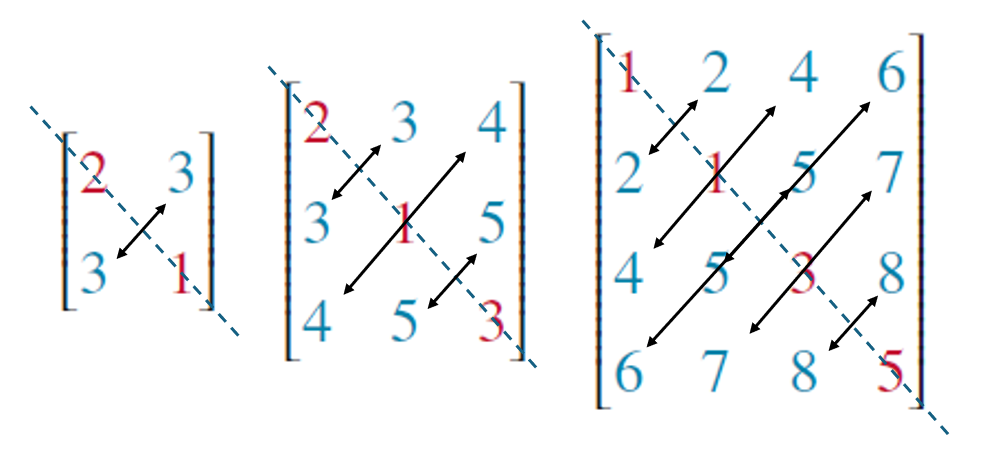
Transpose Matrix
Transpose: swap rows and columns
CAS tip: clear all variables after solving to avoid conflicts
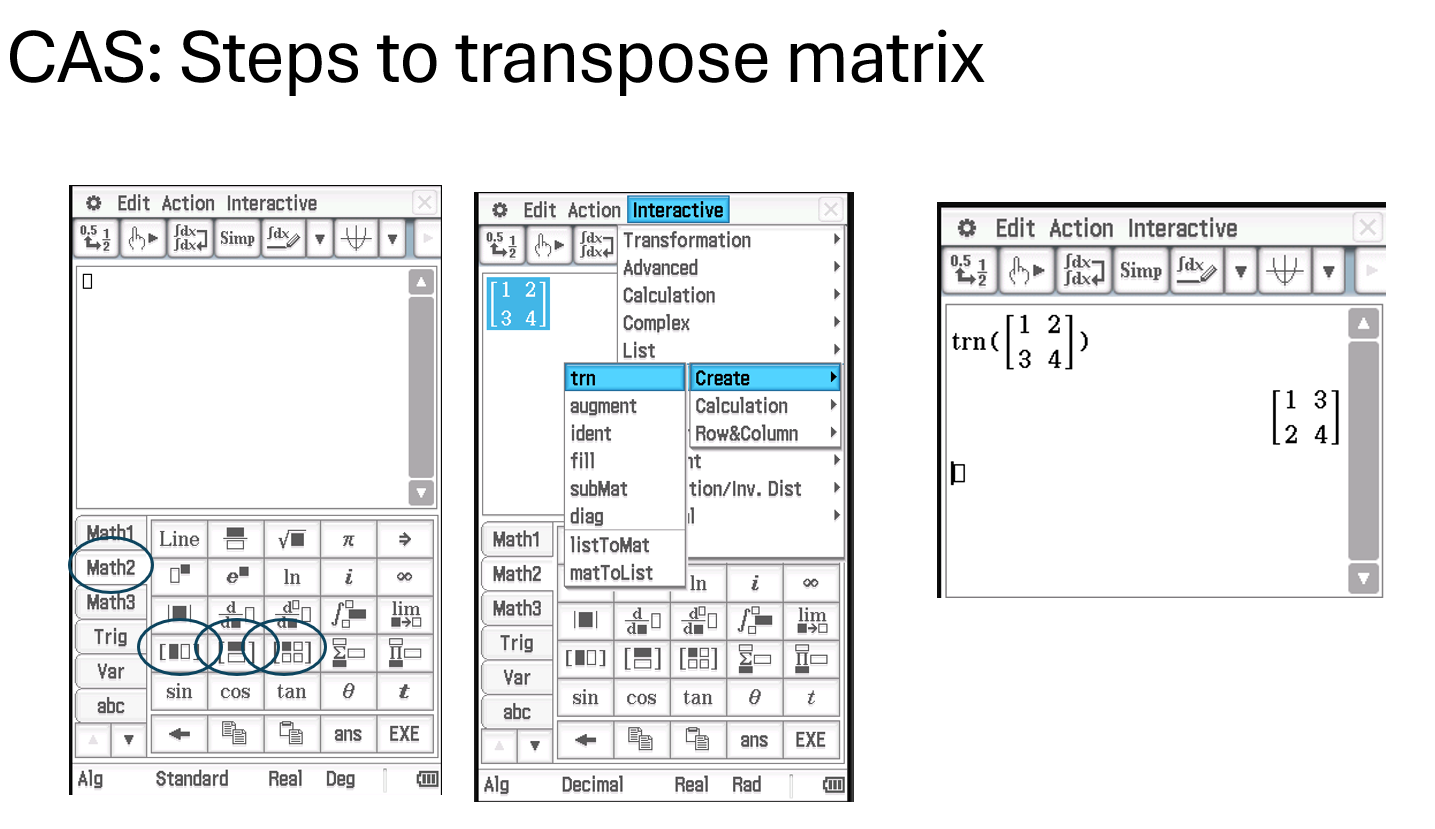
Network Matrices
Represent network with an n × n matrix (n = number of points)
Element = 1 if two points are connected by a line
Element = 0 if two points are NOT connected
Rows and columns correspond to points (nodes)
Matrix shows all connections clearly and simply
Constructing Matrices Using Element Rules (aᵢⱼ)
Each element aᵢⱼ depends on row (i) and column (j) numbers
Apply the given formula/rule to i and j to find each element
Example 1 (Matrix A): aᵢⱼ = i + j
a₁₁ = 1 + 1 = 2
a₁₂ = 1 + 2 = 3
a₂₁ = 2 + 1 = 3
a₂₂ = 2 + 2 = 4
Example 2 (Matrix B): aᵢⱼ = 2i - j
a₁₁ = 2×1 - 1 = 1
a₁₂ = 2×1 - 2 = 0
a₂₁ = 2×2 - 1 = 3
a₂₂ = 2×2 - 2 = 2
Matrix Addition & Subtraction
Add or subtract by adding/subtracting corresponding elements
Only possible if matrices have the same order (same size)
Result matrix keeps the same element positions as originals
Use CAS to make it easier!

Matrix Equality
Two matrices are equal if:
They have the same dimensions (order)
Every corresponding element is equal
If dimensions differ, matrices can’t be added or compared for equality
When given matrices with unknowns (like x, y, p, q), set corresponding elements equal to solve for variables
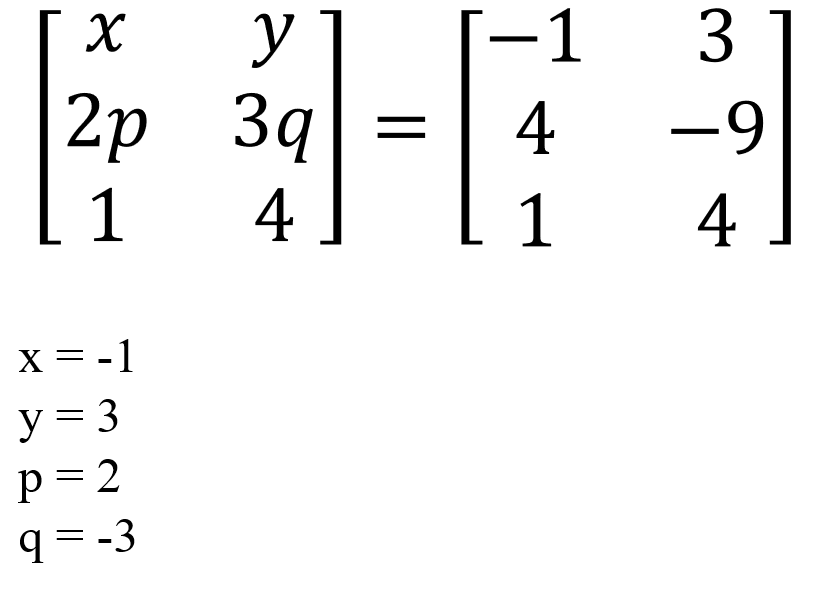
Multiplication by Scalar
Multiply each element of the matrix by the scalar (number)
Like distributing a factor across a bracket in algebra
Keeps matrix size unchanged
Same drill - use your CAS!
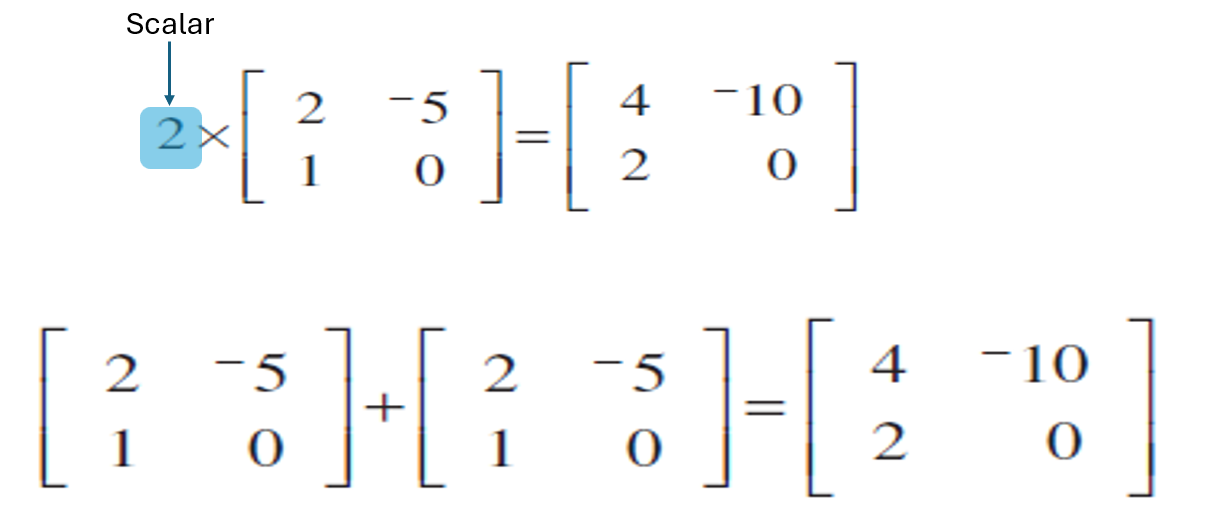
Zero Matrix
A matrix with all elements zero
Can be any order (size)
Symbolized by O (capital letter O)
Acts like zero in matrix addition (A + O = A)
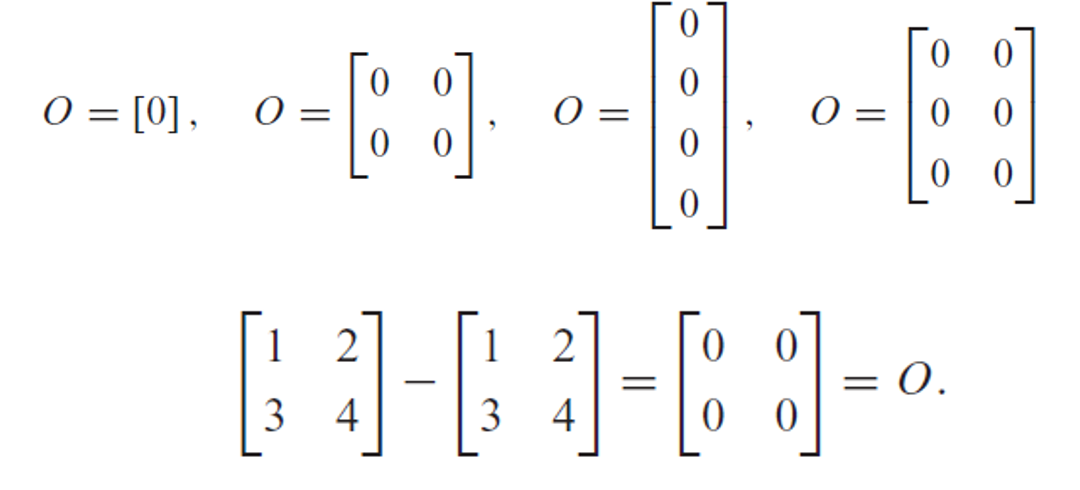
Matrix Multiplication Dimensions
Multiply an m×n matrix by an n×q matrix
Result is an m×q matrix
Columns of 1st = Rows of 2nd (must match)
Each element = sum of products of row i (1st matrix) × column j (2nd matrix)
Result element goes in row i, column j of product matrix

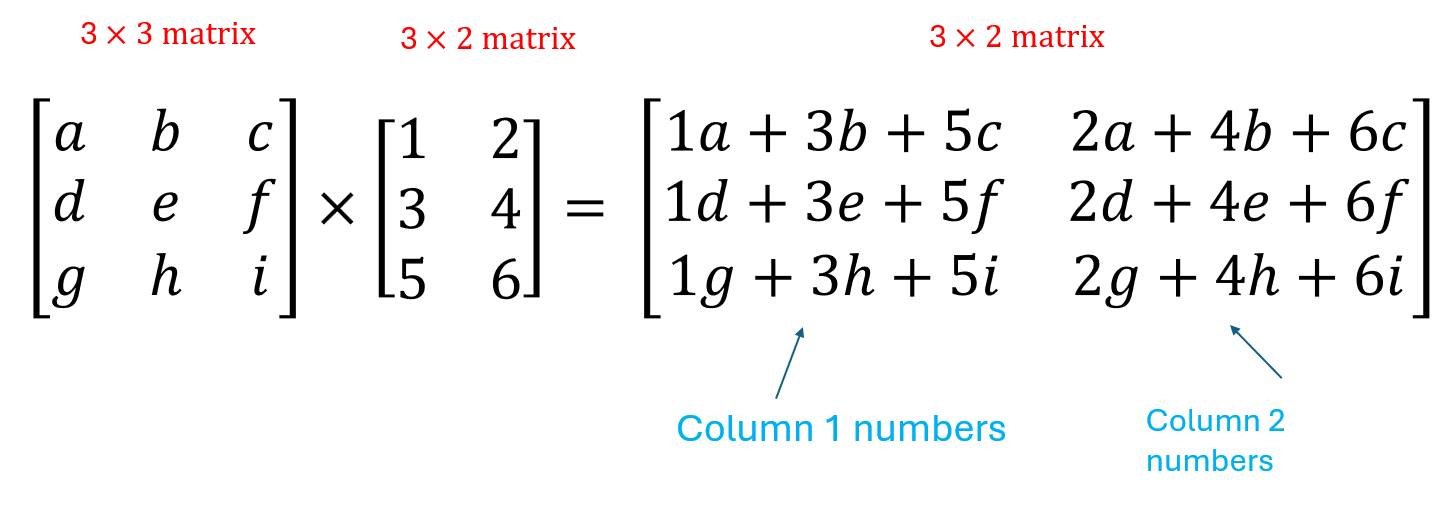
Rules for Summing Rows & Columns
Sum rows of an (m × n) matrix:
Post-multiply by a (n × 1) column summing matrix (all 1’s)
— Result is an (m × 1) matrix with row sumsSum columns of an (m × n) matrix:
Pre-multiply by a (1 × m) row summing matrix (all 1’s)
— Result is a (1 × n) matrix with column sums
Matrix Powers
Raising a matrix to a power = multiplying the matrix by itself repeatedly
NOT just raising each element to that power
Example:
[1 2; 3 4]^2 = [1 2; 3 4] × [1 2; 3 4]
= [1×1 + 2×3 1×2 + 2×4
3×1 + 4×3 3×2 + 4×4]
= [7 10
15 22]
This is NOT equal to
[1^2 2^2
3^2 4^2] = [1 4
9 16]
Only square matrices (same rows and columns) can be raised to powers
Because matrix multiplication requires the number of columns in the first matrix to match rows in the second
Properties of Multiplication of Matrices

We have seen commutative property of multiplication does not hold.. AB ≠ BA!
Determinant of Matrix
For matrix
A = [a b
c d]
Determinant:
det(A) = ad – bcIf det(A) = 0 → no inverse, matrix is Singular
If det(A) ≠ 0 → inverse exists, matrix is Regular
![<p>For matrix</p><p>A = [a b </p><p> c d]</p><ul><li><p>Determinant:<br><strong>det(A) = ad – bc</strong></p></li><li><p>If <strong>det(A) = 0 → no inverse</strong>, matrix is <strong>Singular</strong></p></li><li><p>If <strong>det(A) ≠ 0 → inverse exists</strong>, matrix is <strong>Regular</strong></p></li></ul><p></p>](https://knowt-user-attachments.s3.amazonaws.com/b42910cf-651e-4cbc-888b-df117ee0f7ba.png)
Inverse Matrices
Only square matrices with det(A) ≠ 0 have inverses
For A = [a b
c d]:
A⁻¹ = (1/det(A)) × [ d -b
-c a ]
Steps:
Find det(A) = ad - bc (must ≠ 0)
Swap elements on main diagonal (a ↔ d)
Change signs of off-diagonal elements (b, c)
Multiply entire matrix by 1/det(A)
![<ul><li><p>Only <strong>square matrices</strong> with <strong>det(A) ≠ 0</strong> have inverses</p></li><li><p>For A = [a b </p><p> c d]:</p></li><li><p>A⁻¹ = (1/det(A)) × [ d -b </p><p> -c a ]</p></li></ul><ul><li><p>Steps:</p><ul><li><p>Find det(A) = ad - bc (must ≠ 0)</p></li><li><p><strong>Swap</strong> elements on main diagonal (a <span data-name="left_right_arrow" data-type="emoji">↔</span> d)</p></li><li><p><strong>Change signs</strong> of off-diagonal elements (b, c)</p></li><li><p>Multiply entire matrix by 1/det(A)</p></li></ul></li></ul><p></p>](https://knowt-user-attachments.s3.amazonaws.com/b67b18c4-b61a-4379-9f79-392904837ed7.png)
Special Properties of Inverse Matrices
A⁻¹ is the inverse of matrix A
Multiplying a matrix by its inverse gives the identity matrix:
A × A⁻¹ = I
A⁻¹ × A = I
Identity matrix I acts like 1 in multiplication — no change
Inverse perfectly undoes the matrix operation
Solving Matrix Equations
Like solving linear equations but with matrix twists
Order of multiplication matters — switching sides changes results
No division for matrices
Instead, multiply by the inverse matrix to “divide” and isolate variables
Solving Simultaneous Equations with Matrices
Given system:
2x + 3y = 13
5x + 2y = 16Write as matrix equation:
A × X = B
where
A = [2 3; 5 2]
X = [x; y]
B = [13; 16]Solve by finding X = A⁻¹ × B
(Also can use CAS)
![<ul><li><p>Given system:<br>2x + 3y = 13<br>5x + 2y = 16</p></li><li><p>Write as matrix equation:<br>A × X = B<br>where<br>A = [2 3; 5 2]<br>X = [x; y]<br>B = [13; 16]</p></li><li><p>Solve by finding <strong>X = A⁻¹ × B</strong></p></li><li><p><strong>(Also can use CAS)</strong></p></li></ul><p></p>](https://knowt-user-attachments.s3.amazonaws.com/3c15fd22-5d52-439f-a504-8d91a372b437.png)
Simutaneous Equations with Matrices - No Solution Case
If determinant of matrix A = 0, inverse does not exist
Singular matrix = matrix with determinant = 0 * therefore no solution exists for singular. Any other matrix with determinant ≠ 0 has a solution(s).
IF DET ≠ 0 - INVERSIBLE/NON-SINGULAR MATRIX
IF DET = 0 - NON-INVERSIBLE/SINGULAR MATRIX
No unique solution for the system of equations
Example:
3x + 2y = 9
6x + 4y = 22
Matrix form:
A = [3 2; 6 4], X = [x; y], B = [9; 22]Since det(A) = 3×4 - 6×2 = 12 - 12 = 0, no inverse
So, X = A⁻¹ × B is undefined → no unique solution
Binary Matrices
A binary matrix contains only 0s and 1s
Used for networks, logic, and digital systems
Special binary matrices include:
Summing matrices (all 1s in a row or column)
Identity matrices (1s on diagonal, 0s elsewhere)
Zero matrices (all 0s)
Permutation Matrices
A square binary matrix
Exactly one 1 per row and per column
Used to rearrange rows or columns of another matrix
Pre-multiply → row permutation
Post-multiply → column permutation
TIP: For XPn=X for n is the smallest, n = amount of letters shuffled e.g., 2 letters shuffled = squared.
Inverses:
Every permutation matrix has an inverse
The inverse is just the transpose:
P⁻¹ = Pᵀ
Easy to reverse — just flip rows and columns!
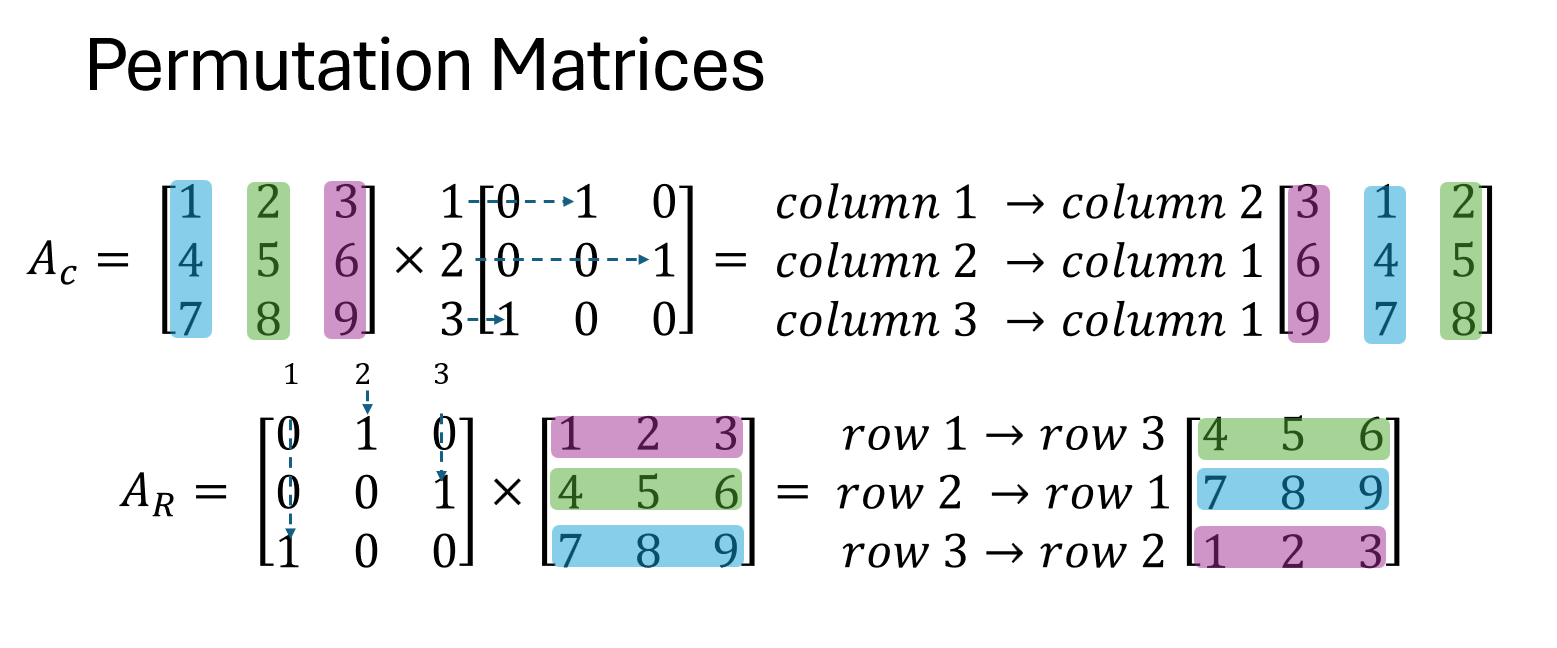
Communication Matrices
Communication matrix: square binary matrix showing who can talk to who
Rows = sender, columns = receiver
1 = direct communication possible, 0 = not possible
Row sum = how many people someone can talk to
Column sum = how many people someone can hear from
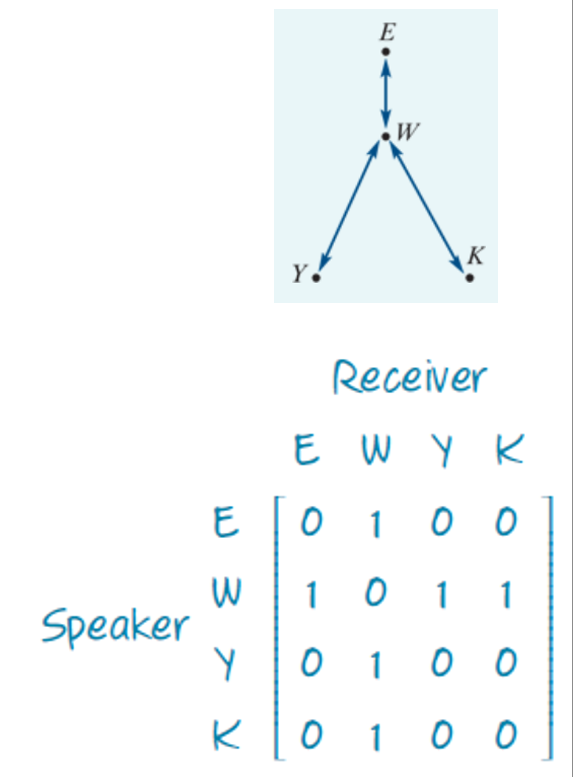
Why use both matrix & network diagram?
Matrix shows data clearly and allows math (like squaring)
Network diagram shows visual relationships (easy to see gaps)
Squaring the matrix reveals two-step communication paths
Two-Step Communication Matrix
Created by squaring the communication matrix → C²
Shows indirect communication (via an intermediary/translator)
1 in C²[i,j] = person i can reach person j in two steps
Leading diagonal = redundant links (person reaching themselves – not useful)
ADD VALUES OF LEADING DIAGONAL TO GET TOTAL REDUNDANT LINKS
Example Insight
C[4,1] = 1: Wong can directly send message to Eva
C²[4,1] = 0: No two-step path from Wong to Eva — already direct, no need for intermediary
Total Communication Links (T = C + C²)
T = C + C²
Adds direct (1-step) and indirect (2-step) communication
Each element in T[i,j] tells how many ways person i can reach person j
Helps analyse the full reachability of each person in the system
T shows who can talk, who needs help to talk, and who’s left out!
![<ul><li><p><strong>T = C + C²</strong></p></li><li><p>Adds <strong>direct (1-step)</strong> and <strong>indirect (2-step)</strong> communication</p></li><li><p>Each element in <strong>T[i,j]</strong> tells how many <strong>ways</strong> person <em>i</em> can reach person <em>j</em></p></li><li><p>Helps analyse the <strong>full reachability</strong> of each person in the system</p></li><li><p>T shows who can talk, who needs help to talk, and who’s left out!</p></li></ul><p></p>](https://knowt-user-attachments.s3.amazonaws.com/0939fab3-6fad-4ea1-a06d-c94bf18a59d7.png)
Redundant Communication Links
Redundant = extra, not needed, adds no new info
In matrix powers:
C³, C⁴... often repeat paths already found in C + C²
Only useful in very large or complex networks
For small systems, powers beyond 2 are usually redundant
As mentioned, add up the diagonal’s value to get total redundant links!
Dominance Matrix
Used in round-robin tournaments
Row = winner, Column = loser
Entry is 1 if row player beat column player
Diagonal is 0 (no self-wins → redundant)
Opposite positions (i,j) and (j,i) are mutually exclusive
Row sum = total wins by that player
It’s the scoreboard of the battlefield — no ties, no mercy!
Dominance Network Diagrams
Visual map of who beats who in a competition
Arrow direction: points from winner (dominant) → loser (non-dominant)
Shows hierarchy of strength or skill
Example:
Anna → Cas, Di
Brigit → Anna, Cas, Emma
Cas → Di
Di → Brigit
Emma → Anna, Cas, Di
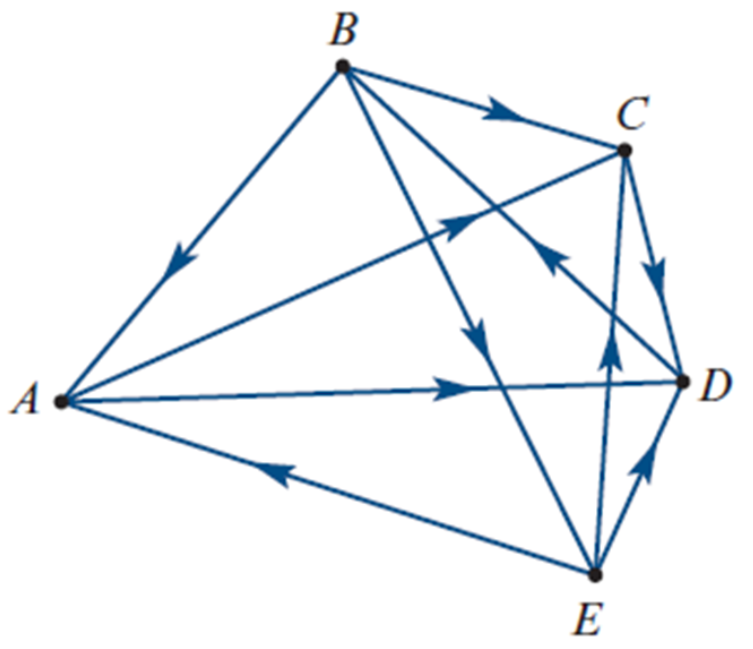
One-step Dominance Matrix
Captures direct wins only — who beat whom in one step
Rows = winner (dominant)
Columns = loser (non-dominant)
Entry = 1 if row player beat column player, else 0
Simplifies dominance network into a neat matrix form

Two-step Dominance
Represents indirect dominance via one intermediary
Found by squaring the one-step dominance matrix
Example: A beat B, who beat C → A two-step dominates C
Helps break ties when players have equal direct wins
Reveals deeper hierarchy beyond immediate wins
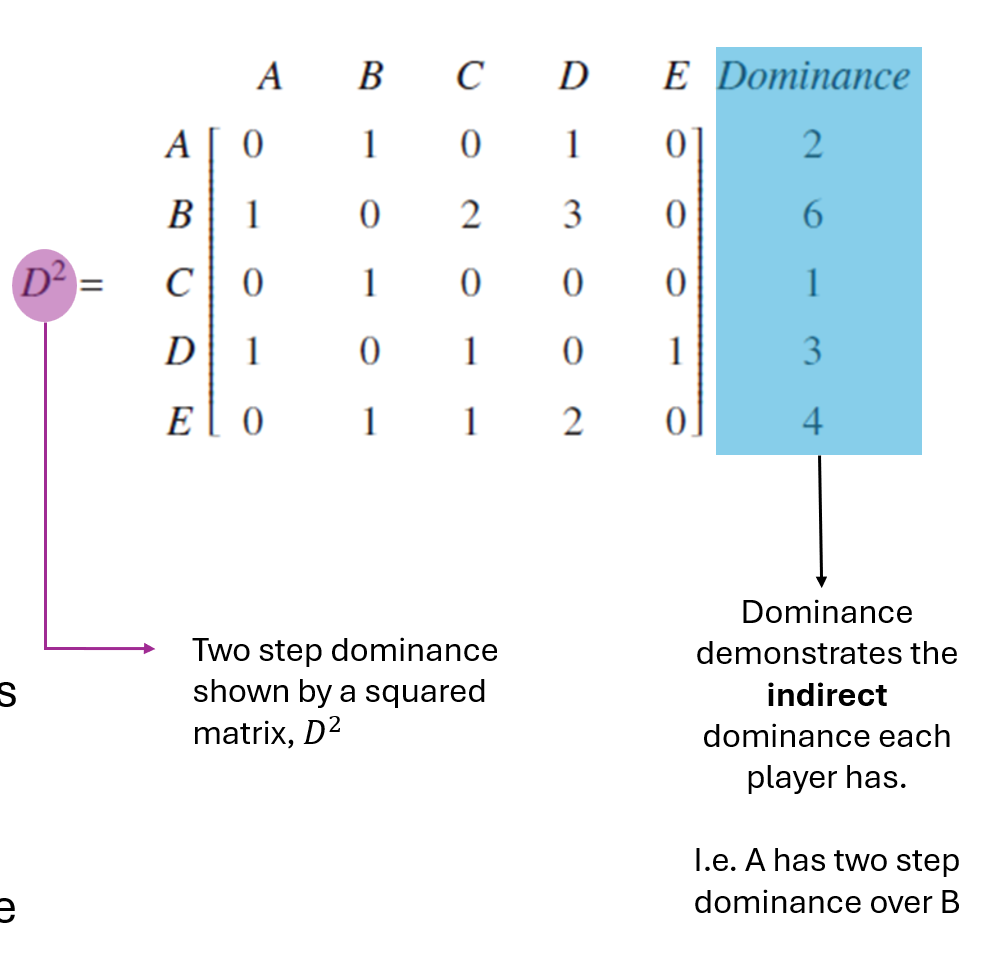
Total Dominance
T = D + D2 combines one-step and two-step dominance
Adds direct wins and indirect influence into one matrix
Sum of each row = total dominance score of that individual
Highest score = most dominant player
Reveals the full picture: immediate victories + power through others
